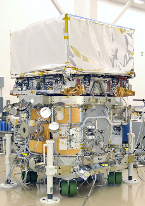
The Fermi Gamma-ray Space Telescope is an international and multi-agency space mission that studies the cosmos in the energy range 10 keV - 300 GeV. Several successful exploratory missions in gamma-ray astronomy led to the Energetic Gamma Ray Experiment Telescope (EGRET) instrument on the Compton Gamma Ray Observatory (CGRO). Launched in 1991, EGRET made the first complete survey of the sky in the 30 MeV - 10 GeV range. EGRET showed the high-energy gamma-ray sky to be surprisingly dynamic and diverse, with sources ranging from the sun and moon to massive black holes at large redshifts. Most of the gamma-ray sources detected by EGRET remain unidentified. In light of the discoveries with EGRET, the great potential of the next generation gamma-ray telescope can be appreciated.
Fermi has an imaging gamma-ray telescope vastly more capable than instruments flown previously, as well as a secondary instrument to augment the study of gamma-ray bursts. The main instrument, the Large Area Telescope (LAT), has superior area, angular resolution, field of view, and deadtime that together will provide a factor of 30 or more advance in sensitivity, as well as provide capability for study of transient phenomena . The Gamma-ray Burst Monitor (GBM) has a field of view several times larger than the LAT and provides spectral coverage of gamma-ray bursts that extends from the lower limit of the LAT down to 10 keV. With the LAT and GBM, Fermi is a flexible observatory for investigating the great range of astrophysical phenomena best studied in high-energy gamma rays.
Mission Characteristics
 Lifetime
Lifetime : Launched 11 June 2008. (Expected to operate for a minimum of five years, but has a goal to operate 10 years.)
 Energy Range
Energy Range : 10 keV - 300 GeV
 Payload
Payload :
- Large Area Telescope (LAT), 20 MeV - 300 GeV
- Gamma-ray Burst Monitor (GBM), 8 keV and 40 MeV
 Archive
Archive:
HEASARC hosts catalogs, products, and raw data.